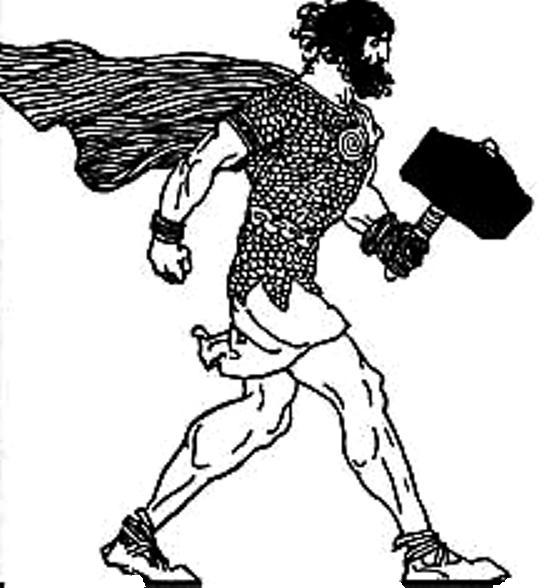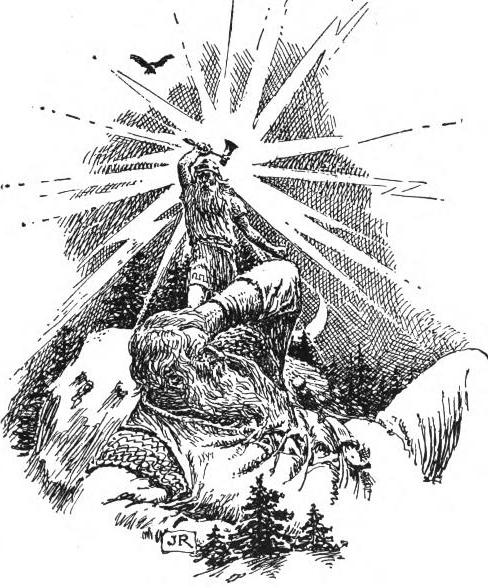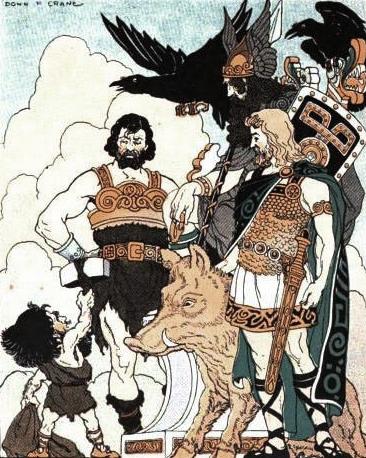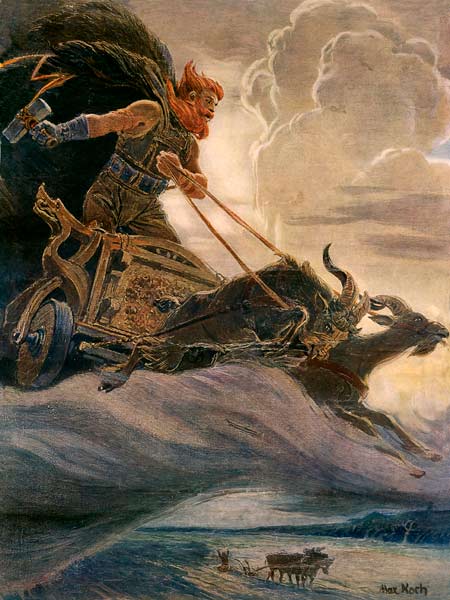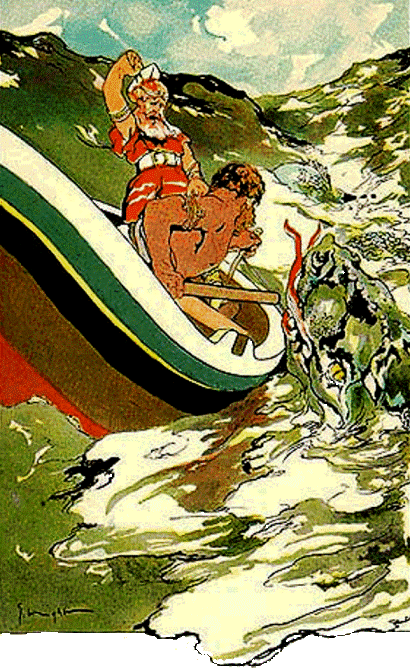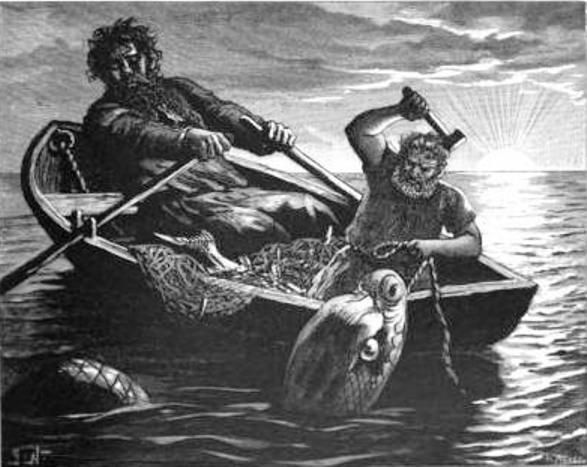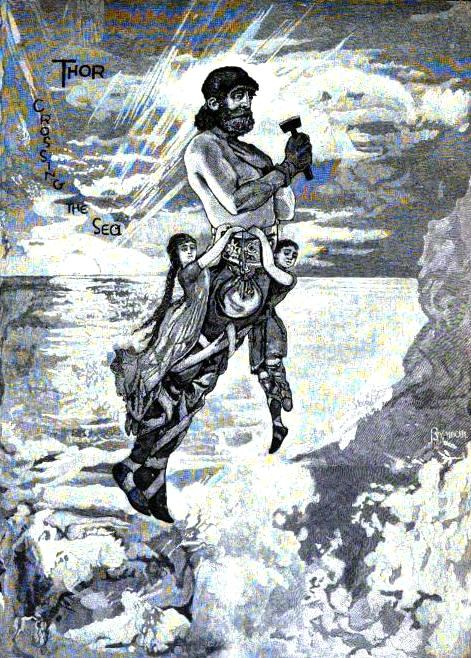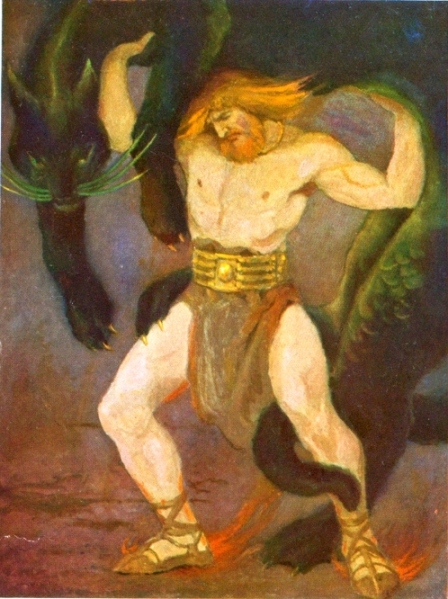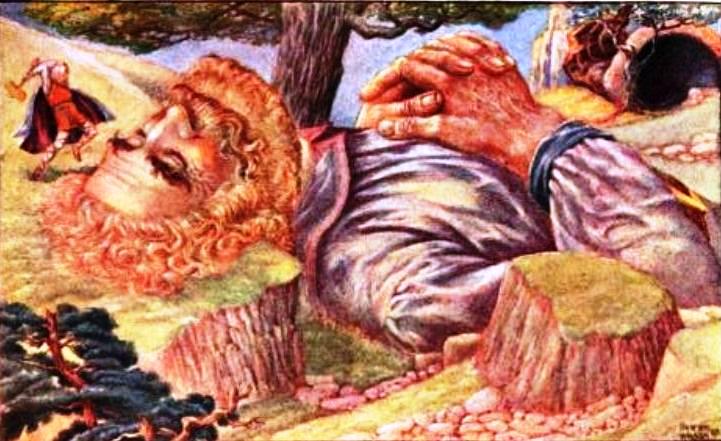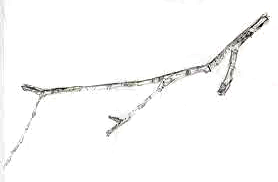| |
Thor's strength, is legendary. In Gylfaginning 21, he is
said to be "the strongest of all the gods and men." According to
Snorri Sturluson, author of the Prose Edda, his mighty strength
manifested itself early, and appears to be an inate part of his
being.
Speaking of Thor as the son of a Trojan king, in a historicized
account of Thor's childhood in the Prologue to Gylfaginning,
Snorri says:
|
Svá var hann fagr álitum,
er hann kom með öðrum mönnum, sem þá er fílsbein er
grafit í eik. Hár hans er fegra en gull. Þá er hann var
tólf vetra, þá hafði hann fullt afl. Þá lyfti hann af
jörðu tíu bjarnarstökkum öllum senn, ok þá drap hann
Lóríkúm hertoga, fóstra sinn, ok konu hans, Lórá eða
Glórá, ok eignaði sér ríkit Trakíá. Þat köllum vér
Þrúðheim. Þá fór hann víða um lönd ok kannaði allar
heimshálfur ok sigraði einn saman alla berserki ok alla
risa ok einn inn mesta dreka ok mörg dýr. |
"When he was twelve
winters old, he had reached his full strength. Then he
lifted from the ground, ten bearskins all at once. and
then he killed his foster father and Loricus’ wife, Lóra
or Gloria, and thus he acquired Thrace. We call this
Thrudheim. Thereafter, he traveled far and explored all
parts of the world and alone conquered all berserkers
and all giants, as well as one of the greatest dragons
and many wild animals." |
The name of Thor's foster father, Loricus, is freely formed from
his wife’s name, Lóra. His actual name is found in
Skáldskaparmál 4, which says that Thor was fóstri Vingnis ok
Hlóru, “fostered by Vingnir and Hlóra.” That Vingnir was
originally a giant is confirmed by the þula of
giant-names added to Skáldskaparmál. Although some translators
attempt to explain Vingnir as an alternate name of Odin here,
and in other passages such as Vafþrúðnismál 53, as an
alternate name of Thor, the context of the passage in the
Prologue to Gylfaginning, shows that Thor, while yet young,
was strong enough to kill giants. In his duel with Hrungnir,
Thor has proven that he can conquer even the mightiest of the giants.
His physical might is unmatched.
From Gylfaginning, we learn that Thor's great strength is
augmented by magical implements.
The mythology is replete with such magical objects, often
described as
the product of dwarf-smiths.
In a famous contest, a group of dwarves or dark-elves
known as the Sons of Ivaldi, forged three wondrous
works for the gods: from gold, they spun a flow of fine hair, which
grew like natural when placed upon the head of Thor's
wife, Sif, after Loki had maliciously cut her beautiful tresses;
for Odin, the Sons of Ivaldi created the spear Gungnir, which
never misses its mark; and for Frey, they crafted a magnificent
sailing ship, Skidbladnir, which can hold all of the gods and
their war-gear, yet which can still be folded up like a napkin
and placed in a pocket. At sail, the ship always finds a favorable wind. As
part of the competition, the dwarf-smith Sindri, assisted by his
brother Brokk, also forged three precious objects: for
Thor, they made the hammer Mjöllnir, which can crush anything
and will always return
to Thor's hand once thrown; for Odin, they crafted the
wealth-producing ring, Draupnir, which drops eight identical
rings every ninth night; and for Frey, they forged the boar
Gullinbursti (also called Slidrugtanni) from an empty pigskin.
Its bristles radiate a golden glow that provides a light to
Frey's path. Nor are these the only magical implements found in the
lore.
We find more among the gods, dwarves and even the giants. Frigg and Freyja
both possess a falcon-dress, allowing them to fly. Odin owns
an eagle-guise. From his throne Hlidskjalf, he can see out over all the worlds.
The Vana-god Frey once owned a sword
that "fights of itself against the giants", until he gave to the
giant Gymir as a bride-price for his daughter (Lokasenna 42). Loki possesses a pair
of shoes, which allow him to fly over land and sea. Freyja wears
the necklace Brisingamen, the best ornament under heaven and the product of a dwarven-smithy. Idunn holds
a basket of golden apples, which serve as "the Æsir's remedy against old age."
The dwarves and giants too possess enchanted items: Sindri owns
an awl that comes to its master when called. The giant Thjazi has a
bar that cannot be let go, and Hymir owns a cup that will not break. |
|
| |
Although the hammer Mjöllnir is the most famous
object that Thor owns, it is not the only magical
device that the thunder god possesses. Gylfaginning 21 states:
|
Hann á ok þrjá kostgripi. Einn þeira er
hamarrinn Mjöllnir, er hrímþursar ok bergrisar kenna, þá
er hann kemr á loft, ok er þat eigi undarligt. Hann
hefir lamit margan haus á feðrum eða frændum þeira.
Annan grip á hann beztan, megingjarðar, ok er hann
spennir þeim um sik, þá vex honum ásmegin hálfu. Inn
þriðja hlut á hann, þann er mikill gripr er í. Þat eru
járnglófar. Þeira má hann eigi missa við hamarskaftit.
En engi er svá fróðr, at telja kunni öll stórvirki hans,
en segja kann ek þér svá mörg tíðendi frá honum, at
dveljast munu stundirnar, áðr en sagt er allt, þat er ek
veit."
|
He has
three things of great price: one is the hammer Mjöllnir,
which the frost-thurses and the mountain-giants know, when it
is raised on high; and that is no wonder, it has smashed
many a skull of their fathers and kinsmen. He
has a second precious thing, best of all: the belt of
strength; and when he buckles it about him, then his
divine
strength is doubled. Yet a third
thing he has, in which there is much virtue: his iron
gloves; he must not be without them when he grips the
hammer-shaft."
|
|
|
| |
Here, Snorri tells us that Thor must wear a pair of special
gloves to wield his lightning-hammer. Although it often goes
unsaid, this seems reasonable
considering what we know of that mighty weapon. This passage
also says that when Thor buckles on his
megingjarðar, "belt of strength", that his
ásmegin, "divine strength" is doubled. Since Thor is
already the mightiest of the Æsir, and capable of killing giants
since childhood, this seems like an odd thing for him to have. So
odd, in fact, that few popular books on mythology mention it,
and when they do, place little emphasis on it. If Thor is already
the mightiest being in the nine worlds, capable of holding his
own against even "old age" (Elli in Utgard-Loki's court),
what use is a belt that doubles his already superior strength? At
best, it seems redundant. In practical terms, what would such a device
do for Thor, the strongest of the gods? The myths provide us
some clue about the nature of this belt.
Thor's strength is specifically refered to as his ásmegin
('divine strength'). The term appears several times in the lore,
where it is frequently associated with his belt
megingjarðar. In the Prose Edda, Thor's use of his ásmegin
is mentioned in his fishing expedition with Hymir, and again in
his encounter with the giant Skyrmir, also known as Utgard-Loki.
In Gylfaginning, 48 (Faulkes' tr.), Snorri says: |
|
| |
|
Hafði þá Hymir út skotit
nökkvanum. Þórr gekk á skipit ok settist í austrrúm, tók
tvær árar ok reri, ok þótti Hymi skriðr verða af róðri
hans. Hymir reri í hálsinum fram, ok sóttist skjótt
róðrinn. Sagði þá Hymir, at þeir váru komnir á þær
vastir, er hann var vanr at sitja ok draga flata fiska,
en Þórr kveðst vilja róa miklu lengra, ok tóku þeir enn
snertiróðr. Sagði Hymir þá, at þeir váru komnir svá
langt út, at hætt var at sitja útar fyrir Miðgarðsormi,
en Þórr kveðst myndu róa enn um hríð, ok svá gerði hann,
en Hymir var þá allókátr.
En þá er Þórr lagði upp árarnar, greiddi hann til vað
heldr sterkjan, ok eigi var öngullinn minni eða
óramligri. Þar lét Þórr koma á öngulinn uxahöfuðit ok
kastaði fyrir borð, ok fór öngullinn til grunns, ok er
þér þat satt at segja, at engu ginnti þá Þórr miðr
Miðgarðsorm en Útgarða-Loki hafði spottat Þór, þá er
hann hóf orminn upp á hendi sér.
Miðgarðsormr gein yfir
uxahöfuðit, en öngullinn vá í góminn orminum. En er
ormrinn kenndi þess, brá hann við svá hart, at báðir
hnefar Þórs skullu út at borðinu. Þá varð Þórr reiðr ok
færðist í ásmegin, spyrnði
við fast, svá at hann hljóp báðum fótum gegnum skipit ok
spyrnði við grunni, dró þá orminn upp at borði.
|
"Thor went aboard the skiff and sat down in the
stern-seat, took two oars and rowed; and it seemed to
Hymir that swift progress came of his rowing. Hymir
rowed forward in the bow, and the rowing proceeded
rapidly; then Hymir said that they had arrived at those
fishing-banks where he was wont to anchor and angle for
flat-fish. But Thor said that he desired to row much
further, and took a sharp pull; then Hymir said
that they had come so far that it would be perilous to
go farther because of the Midgard Serpent. Thor replied
that he would row a while yet, and so he did; but
Hymir was then deathly afraid.
As soon as Thor had put up the oars, he made ready a very strong fishing-line,
and the hook was no less large and strong. Then Thor put
the ox-head on the hook and cast it overboard, and the
hook sank to the bottom; and it is telling the
truth to say that Thor then beguiled the Midgard Serpent
no less than Útgarda-Loki had mocked Thor, at the time
when he lifted the Serpent (in the guise of a cat) up in his hand.
"The Midgard Serpent snapped at the ox-head, and the
hook caught in its jaw; but when the Serpent was aware
of this, it bolted away so fiercely that both of Thor's
fists crashed against the gunwale. Then Thor got
angry, and summoned up his divine strength,
braced his feet so strongly that he plunged through the
ship with both feet, and pushed his feet against the
ground.
|
|
|
| |
|
|
|
Here, Thor's might is
referred to as his ásmegin. It is something
that he "summons up" (færðist
í ásmegin),
although the passage does not say how. Once activated,
however, Thor is so strong that when he pushes against the
bottom of the boat,
his feet break through the floorboards. That this was a
widespread motif is evident from its appearance on two
Viking Age runestones. The Altuna Stone, dated to the early
11th century, and the Hørdum stone, dated from the 8th to
the 11th century, both show Thor with his feet protruding
from the bottom of Hymir's boat.
The Altuna
Runestone |
 |
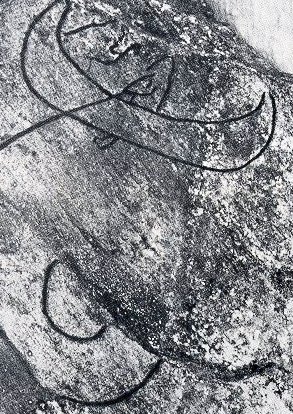 |
The Hørdum
Runestone |
That Thor is strong enough to break through
the bottom of a boat is not surprising. But Snorri adds another
detail that often goes unnoticed. He specifically says that
Thor's feet
spyrnði við grunni,
"pushed with his feet against the ground".
The operative words here are
spyrnði, which
means "to push or kick with the feet";
and grunni, which means the "bottom (of the
sea)", according to Faulkes [Edda:
Prologue and Gylfaginning, Glossary]. In other
words, Thor's feet touched the sea-floor, while he still sat in
Hymir's boat. This cannot be explained by mere strength.
The same source says that Thor and Hymir had rowed far out to
sea, into the territory of the Midgard serpent, which rings the
entire world. Considering the depths of the ocean at this
distance, Thor would have had to grow in physical size so that he would be tall enough to stand
on the ocean floor. This happens when he
færðist í ásmegin,
"summons up his divine strength" [A.
Faulkes, Edda: Prologue and Gylfaginning, Glossary p. 98, s.v.
færa]. Snorri says Thor
grew in "divine strength" so that he could touch the bottom.
|
|
| |
That this is a recurring motif is made more explicit in verse 7
of the skaldic poem Þórsdrápa, which places an emphasis
on the belt at the point Thor displays his mighty "megin" as he crosses
a raging river. Snorri may have even gotten his idea for the
"belt of strength" as a misunderstanding of this verse. at least
one scholar has suggested it.
|
Harðvaxnar lét herðir
halllands of sik falla;
gatat maðr, njótr, hin neytri,
njarð-, ráð fyrir sér, -gjarðar.
Þverrir lét, nema þyrri
þorns, barna sér mörnar,
snerriblóð, til, svíra,
salþaks megin vaxa.
|
The promoter of the whetstone-land
[warrior] let the mightily-swollen ones [waves] fall
over him. The man, who benefited from the girdle of
might [Thjalfi], knew no better course of action. The
diminisher of Mörn's children [Thor] threatened that his
power would grow unto the hall's roof [heaven], unless
the gushing-blood of Þorn's neck [ocean] would diminish.
|
As the waves rose, Thor threatened to
grow unto heaven itself if need be. Thjalfi, who would
otherwise drown, thus is njótr njarðgjarðar, "he
who benefits from the mighty belt."
The picture painted by
the poet is clear: Thor, the mighty god, to whom the
ocean is no more than a river, allows its
icy waves to wash over him. His servant Thjalfi clings to his
master's belt in order not to be swept away by the swollen
waves. Thor's ability to grow ( vaxa) to heaven
itself, is stated explicitly and seems to be connected to
the belt that "doubles" his strength. This ability, as strange as it may seem, is
not unknown in the ancient lore. Book 1 of Saxo's Danish History,
based on Icelandic documents and written in Denmark a generation
before the Prose Edda, says:
|
1 Quo corporis eius magnitudinem humanis
inhabilem amplexibus referente, cuius naturae contextum
dubium non esset giganteo germini respondere: 2 'Non te
moveat', inquit, 'insolitus meae granditatis aspectus. 3
Nunc enim contractioris, nunc capacioris, nunc exilis,
nunc affluentis substantiae, modo corrugati, modo
explicati corporis situm arbitraria mutatione
transformo; nunc proceritate caelis invehor, nunc in
hominem angustioris habitus condicione componor.' 4
Adhuc haesitante eo fidemque dictis habere cunctante,
tale carmen adiecit:
5
Ne paveas nostri, iuvenis, commercia lecti.
6
Corpoream gemina vario ratione figuram
et duplicem nervis legem praescribere suevi.
7
Nam sequor alternas diverso schemate formas
arbitrio variata meo; nunc sidera cervix
aequat et excelso rapitur vicina Tonanti,
rursus in humanum ruit inclinata vigorem
contiguumque polo caput in tellure refigit.
8
Sic levis in varios transmuto corpora flexus |
When [Hadding] answered that the size of her
body was unwieldy for the embraces of a mortal, since
doubtless her nature was framed in conformity to her
giant stock, [Hardgrep] said: "Be not moved by my
unwonted look of size. For my substance is sometimes
thinner, sometimes ampler; now meagre, now abundant; and
I alter and change at my pleasure the condition of my
body, which is at one time shrivelled up and at another
time expanded: now my tallness rises to the heavens, and
now I settle down into a human being, under a more
bounded shape." As he still faltered, and was slow to
believe her words, she added the following song:
Youth, fear not the converse of my bed.
I change my bodily outline in twofold wise,
and am wont to enjoin a double
law upon my sinews.
For I conform to shapes of different figure in turn,
and am altered at my own sweet will:
now my neck is star-high,
and soars near to the lofty Thunderer;
then it falls and declines to human strength,
and plants again on earth that head which was
near the firmament.
Thus I lightly shift my body into diverse phases.
(Oliver Elton tr. 1898)
|
|
|
| |
| Comic Book
Characters Who Can Grow To Extraordinary Size: |
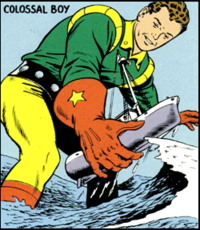 |
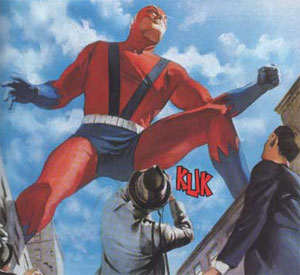 |
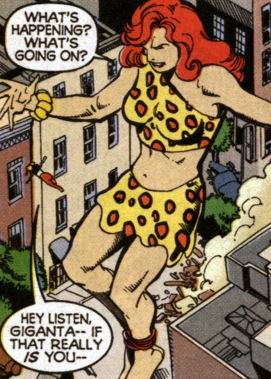 |
Colossal Boy of the
Legion of Super-Heroes |
Giant-Man of the
Avengers |
Giganta of the
Legion of Doom |
|
|
|
| |
This ability —the power to grow in height to meet
any threat no matter the size—appears again in Thor's
journey to the giant Geirröd. Captured by Geirröd, Loki
promises to lure Thor into Jötunheim without his hammer,
gloves or his magic belt. He accomplishes this plot, but
along the way, Thor borrows like items from a friendly
giantess named Grid:
|
Þá læsti Geirröðr Loka í kistu ok svelti hann þar
þrjá mánuðr. En þá er Geirröðr tók hann upp ok beiddi
hann orða, þá sagði Loki, hverr hann var, ok til
fjörlausnar vann hann Geirröði þess eiða, at hann skyldi
koma Þór í Geirröðargarða, svá at hann hefði hvárki
hamarinn né megingjarðar.
|
Geirrödr shut Loki into a chest and starved him there
three months. And now when Geirrödr took him out and
commanded him to speak, Loki told who he was; and by way
of ransom for his life he swore to Geirrödr with oaths
that he would get Thor to come into Geirrödr's dwelling
in such a fashion that he should have neither hammer nor
Girdle of Might with him.
|
|
Þórr kom til gistingar til gýgjar þeirar, er Gríðr er
kölluð. Hon var móðir Víðars ins þögla. Hon sagði Þór
satt frá Geirröði, at hann var jötunn hundvíss ok illr
viðreignar. Hon léði honum megingjarða ok járngreipr, er
hon átti, ok staf sinn, er heitir Gríðarvölr. Þá fór
Þórr til ár þeirar, er Vimur heitir, allra á mest. Þá
spennti hann sik megingjörðum ok studdi forstreymis
Gríðarvöl, en Loki helt undir megingjarðar. Ok þá er
Þórr kom á miðja ána, þá óx svá mjök áin, at uppi braut
á öxl honum. Þá kvað Þórr þetta: |
"Thor came to spend the night with that giantess who was
called Grídr, mother of Vídar the Silent. She told Thor
the truth concerning Geirrödr, that he was a crafty
giant and ill to deal with; and she lent him the Girdle
of Might and iron gloves which she possessed, and her
staff also, which was called Grídr's Rod. Then Thor
proceeded to the river named Vimur, greatest of all
rivers. There he girded himself with the Girdle of Might
and braced firmly downstream with Grídr's Rod, and Loki
held on behind by the Girdle of Might. When Thor came to
mid-current, the river grew so great that it broke
high upon his shoulders. Then Thor sang this (to the
river): |
|
65. Vax-at-tu nú, Vimur,
alls mik þik vaða tíðir
jötna garða í;
veiztu, ef þú, vex,
at þá vex mér ásmegin
jafnhátt upp sem himinn.
|
"Do not rise now, Vimur,
For I desire to wade
into the giants' gard:
Know that if you rise,
Then divine-strength will grow in me
As high up as the heaven!" |
|
|
|
The fact that Thor can reach great heights is clearly
expressed in Gylfaginning 46-47, when as part of the games in
Utgard-Loki's hall, he is asked to lift the giant's cat:
Þá mælti Útgarða-Loki:
"Þat gera hér ungir sveinar, er lítit mark mun at
þykkja, at hefja upp af jörðu kött minn, en eigi myndak
kunna at mæla þvílíkt við Ása-Þór, ef ek hefða eigi sét
fyrr, at þú er miklu minni fyrir þér en ek hugða."
Því næst hljóp fram köttr einn grár á hallargólfit ok
heldr mikill, en Þórr gekk til ok tók hendi sinni niðr
undir miðjan kviðinn ok lyfti upp, en kötttrinn beygði
kenginn, svá sem Þórr rétti upp höndina. En er Þórr
seildist svá langt upp sem hann mátti lengst, þá létti
kötturinn einum fæti, ok fekk Þórr eigi framit þenna
leik meir.
Þá mælti Útgarða-Loki: "Svá fór þessi leikr sem mik
varði. Köttrinn er heldr mikill, en Þórr er lágr ok
lítill hjá stórmenni því, sem hér er með oss."
|
Then said Útgarda-Loki:
'Young boys here are wont to do this (which is thought
of small consequence): lift my cat up from the ground;
but I would not have been able to speak of such a thing
to Ása-Thor if I had not seen for myself that you have far less in
you than I had thought.' With that, a gray cat and a
very big one at that, leaped forth
onto the hall-floor;
Thor went to it and grappled it with his hand under the
middle of its belly and lifted it up. But the cat arched
its back as high as Thor could hold his hands up. When
Thor reached up the utmost he could muster,
the cat lifted up one foot, and Thor advanced
no further in this game. Then Útgarda-Loki said: 'This game
went as I had foreseen; the cat is very great,
whereas Thor is small and puny beside the huge men who
are here with us.' |
|
Utgard-Loki accomplished this feat by means of an
illusion. All was not as it seemed. The grey cat
was none other than the Midgard serpent: |
|
"Eigi
þótti mér hitt minna vera vert, er þú lyftir upp
kettinum, ok þér satt at segja, þá hræddust allir þeir,
er sá, er þú lyftir af jörðu einum fætinum. En sá köttr
var eigi sem þér sýndist. Þat var Miðgarðsormr, er liggr
um öll lönd, ok vannst honum varliga lengð til, at
jörðina tæki sporðr ok höfuð, svá langt seildist þú upp,
at skammt var þá til himins.
|
That
cat was not as it appeared: it was the Midgard
Serpent, which lies around all the land, and scarcely
does its length encompass the earth between head
and tail. So high did you stretch your arms that
it was but a little way more to heaven.
|
|
|
Thor can
almost reach as high as the heavens. But no matter how
tall Thor grew, he could not reach higher than the length of
the snake, who encircles the world, biting its own tail.
Thor grew so tall that he could almost reach
heaven, but that the snake was still longer is not surprising.
Of its brother, the Fenris Wolf, Gylfaginning 51 says:
|
Fenrisúlfr ferr
með gapandi munn, ok er inn neðri kjöftr við
jörðu, en in efri við himin. Gapa myndi hann
meira, ef rúm væri til. |
The Fenris-Wolf
shall advance with gaping mouth, and his lower
jaw shall be against the earth, but the upper
against heaven,--he would gape yet more if there
were room for it. |
Of interest, Hymiskviða 22 refers to Thor's
opponent, the Midgard serpent, as umgjörð
allra landa "the girdle of all lands". The exact kenning is also found in a
poetic fragment,
preserved in Skáldskaparmál 43,
attributed to Ölvir hnúfa, a 9th century skald. From the
9th century poet Bragi the skald, we also find the paraphrase
endiseiðr allra landa
"boundary-fish of all lands" (Skáldskaparmál 48).
Kennings of this
type also indicate the ocean. For
example, umband allra landa, "belt of all lands" (Hallvarðr Háreksblesi, 11th century, Skáldskaparmál
348). This may be a conscious play of words, referring to
Thor's own megin-gjarðar, which allows him to
grow in size to confront this enemy face to face. The
Midgard Serpent, of course is his most frequent foe. The
lore tells of three encounters between them, more than
any other opponent.
That Thor grows in height to face his opposers makes
sense in the context of his other adventures. In
Gylfaginning
45, when Thor first meets Utgard-Loki in the guise of the
giant Skrymir. He wakes to find himself sleeping in the
giant's glove. Throughout the night, Thor and his
companions heard a mighty rumbling which had disturbed
their sleep: |
En er kom at dagan, þá
gekk Þórr út ok sér mann, hvar lá skammt frá honum í
skóginum, ok var sá eigi lítill. Hann svaf ok hraut
sterkliga. Þá þóttist Þórr skilja, hvat látum verit
hafði of nóttina. Hann spennir sik megingjörðum, ok óx
honum ásmegin. Ok í því bili vaknar sá maðr ok stóð
skjótt upp, en þá er sagt, at Þór varð bilt einu sinni
at slá hann með hamrinum ok spurði hann at nafni.
|
"But when it drew near
dawn, then Thor went out and saw a man lying a little
way from him in the wood; and that man was not small; he
slept and snored mightily. Then Thor thought he could
perceive what kind of noise it was which they had heard
during the night. He girded himself with his belt of
strength, and his divine strength grew; and on the instant
the man awoke and rose up swiftly; and then, it is said,
the first time Thor's heart failed him, to strike him
with the hammer. |
Thor has faced many giants, including Hrungnir, the
mightest of them all, without any fear. But Skyrmir's appearance upon
rising makes his heart fail for the first time. Thor's
moment of fear is made all the more poignant, when we
realize that he had grown to his full height, and
Skyrmir was still taller than him! Just as the Midgard
Serpent, disguised as a cat, will be as the adventure
progresses. We know this because, the passage explicitly
states that Thor had "girded himself with his belt of
strength, and his divine strength grew," before Skyrmir
himself had risen.
The following night, Thor again attempts to kill the
giant as he lies sleeping: |
|
En at miðri nótt, þá
heyrir Þórr, at Skrýmir hrýtr ok sefr fast, svá at dunar
í skóginum. Þá stendr hann upp ok gengr til hans, reiðir
hamarinn títt ok hart ok lýstr ofan í miðjan hvirfil
honum. Hann kennir, at hamarsmuðrinn sökkr djúpt í
höfuðit. |
At midnight Thor heard how
Skrýmir snored and slept fast, so that it thundered in
the woods; then he stood up and went to him, eagerly swung his
hammer and hard, and smote down upon the middle
of his crown: he saw that the face of the hammer sank
deep into his head. |
|
|
En í því bili vaknar
Skrýmir ok mælti:
"Hvat er nú? Fell akarn nökkut í höfuð mér, eða hvat er
títt um þik, Þórr?"
En Þórr gekk aftr skyndiliga ok svarar, at hann var þá
nývaknaðr, sagði, at þá var mið nótt ok enn væri mál at
sofa.
Þá hugsaði Þórr þat, ef
hann kæmi svá í færi at slá hann it þriðja högg, at
aldri skyldi hann sjá sik síðan, liggr nú ok gætir, ef
Skrýmir sofnaði enn fast. En litlu fyrir dagan þá heyrir
hann, at Skrýmir mun sofnat hafa, stendr þá upp ok
hleypr at honum, reiðir þá hamarinn af öllu afli ok
lýstr á þunnvangann, þann er upp vissi. Sökkr þá
hamarrinn upp at skaftinu.
En Skrýmir settist upp ok strauk of vangann ok mælti:
"Hvárt munu fuglar nökkurir sitja í trénu yfir mér? Mik
grunaði, er ek vaknaða, at tros nökkut af kvistunum
felli í höfuð mér. Hvárt vakir þú, Þórr? Mál mun vera
upp at standa ok klæðast, en ekki eiguð þér nú langa
leið fram til borgarinnar, er kölluð er Útgarðr. Heyrt
hefi ek, at þér hafit kvisat í milli yðvar, at ek væra
ekki lítill maðr vexti, en sjá skuluð þér þar stærri
menn, ef þér komit í Útgarð. |
And at that moment Skrýmir
awoke and said:
'What is it now? Did some acorn fall on my
head? Or what is the news with thee, Thor?' But Thor
went back speedily, and replied that he was then but
newly-wakened; said that it was then midnight, and there
was yet time to sleep.
Thor meditated that if he could get to strike him a
third blow, never should the giant see himself again; he
lay now and watched whether Skrýmir were sleeping
soundly yet. A little before day, when he perceived that
Skrýmir must have fallen asleep, he stood up at once and
rushed over to him, brandished his hammer with all his
strength, and smote upon that one of his temples which
was turned up. But Skrýmir sat up and stroked his cheek,
and said: 'Some birds must be sitting in the tree above
me; I imagined, when I awoke, that some dirt from the
twigs fell upon my head. Art thou awake, Thor? It will
be time to arise and clothe us; but now ye have no long
journey forward to the castle called Útgardr. I have
heard how ye have whispered among yourselves that I am
no little man in stature; but ye shall see taller men,
if ye come into Útgardr. |
| When
Utgard-Loki reveals to Thor that the entire journey to his
realm was riddled with deception, he explains the truth
of the matter: |
|
Þá mælti Útgarða-Loki: "En sjónhverfingar hef ek gert þér, svá at
fyrsta sinn á skóginum kom ek til fundar við yðr, ok þá
er þú skyldir leysa nestbaggann, þá hafðak bundit hann
með grésjárni, en þú fannt eigi, hvar upp skyldi lúka.
En því næst laust þú mik með hamrinum þrjú högg, ok var
it fyrsta minnst ok var þó svá mikit, at mér mundi
endast til bana, ef á hefði komit. En þar er þú sátt hjá
höll minni setberg ok þar sáttu ofan í þrjá dali
ferskeytta ok einn djúpastan, þar váru hamarspor þín |
Then said Útgardi-Loki:
'I made use of
eye-spells (illusions) against you when I came upon you the first time in the
wood. When you would have unloosed the
provision-bag, I had bound it with iron, and you did
not find where to undo it. But next you smote me
three blows with the hammer; and the first was least,
and was yet so great that it would have sufficed to slay
me, if it had come upon me. Near my hall, where you saw a saddle-backed mountain, cut at the top into
threesquare dales, and one the deepest, those were the
marks of your hammer. |
To make such deep marks in the mountains, it stands to reason
that Thor himself was as large as them when he swung the hammer
at Skyrmir's head.
|
|
| |
That this power is not intrinsic to Thor, but lies in a magic
device, is made clear by Harbardsljóð. There Thor cannot wade
across the water for fear of getting his
augur (balls?) wet.
Perhaps this happened as he returned home from Geirrod's without
his hammer, belt or gloves. On that occassion, he borrowed
comparable implements from the giantess Grid, and presumably
returned them to her before heading home.
The same may be behind the curious phrase reis á kné in
Hymiskviða 31. Preparing to smash the giant's magic goblet which
will not break, against the old giant's thick skull, Thor again
fills himself with ásmegin: |
|
| |
|
31. Harðr reis á kné
hafra dróttinn,
færðiz allra
í ásmegin.
Heill var karli
hjálmstofn ofan,
en vínferill
valr rifnaði.
|
The sturdy lord of goats rose to his
feet, and filled himself with divine strength.
The old man's helmet-stump remained intact, but the oval
wine-path shattered.
|
The phrase reis á kné,
literally "rose to his knees" simply means "stood up", "rose to his feet",
as any part of a thing can be used poetically to designate the
whole. Just as Thor wasn't frightened until he saw Skyrmir rise
to his feet, the expression seems to indicate that Thor stood
taller than usual— no doubt because he had filled himself with
ásmegin.
This may also be the meaning behind Hymiskviða 34, which
transfers the motif of Thor's feet penetrating Hymir's boat
to Hymir's hall. When Thor picks up the giant's kettle, his
feet penetrate the floorboards of the giant's hall:
|
34. Faðir Móða fekk á þremi
ok í gegnum steig gólf niðr í sal.
hóf sér á höfuð upp hver Sifjar verr,
en á hælum hringar skullu.
|
Móði's father (Thor) seized it by
the rim,
and his feet sank down into the floor of
the hall.
Sif's husband heaved the cauldron up on his
head,
and the handles banged against his heels.
|
Thor wears the great cauldron as a hat, as he
leaves Hymir's hall. This cauldron is the greatest of all. Although the
meaning of ok í gegnum steig gólf niðr í sal is obvious to the
Icelandic speaker, they have been misunderstood by almost all of
the English translators. The expression stíga niðr í gegnum gólf
strictly expresses vertical motion. This has been
understood by the Icelandic scholars of the Poetic Edda for
centuries. Of the English translators, only Benjamin Thorpe
(1865) got it correct. He says: "Then
Modi’s father by the brim grasped it, and trod through the
dwelling’s floor." That Thor sinks into the floor
when he lifts the kettle is probably not because of its great weight
alone, but also because of his great size. He walks across the
hall, crushing the floorboards, in this fashion.
When Thor demands that Aegir brew beer for all of the
gods, the sea-giant requests a kettle large enough to do
so. Among the gods, Thor's drinking goblets are the largest
(Skáldskaparmál 24). When he drinks from a horn connected to the
sea at Utgard-Loki's, Thor drinks so much that water level
lowers noticeably, like at ebbtide (Gylfaginning 46). In
any event, Aegir often holds large-scale drinking feasts for the
gods, as in Lokasenna. Thus his brewing kettle must be large
enough to brew beer for all of the gods, not just Thor the
mighty imbiber, so certainly
it is heavy, but it is also had to be very deep. Since the
kettle is given to the sea-giant Aegir, it may be a symbol of the
sea itself. As he leaves Hymir's, Thor carries the kettle over
his head and its "handles bang on his heels." This implies that
Thor was not only large enough to grasp it, but that both of its
swinging handles (hringar) were able to strike his
feet as he walked. This could only happen if he was large enough
to grasp both sides of the kettle's rim.
As it would be redundant otherwise, the true
purpose of Thor's magic megin-gjardar
("belt-of-strength") seems to be to increase his physical
size so that he may meet his foes face-to-face. Thor's
belt is not mentioned in any of the Eddic poems. It is unique to
Snorri's text, where it is mentioned just a few times.
|
|
| |
For
additional insight on Thor's wading, see
Thor's Burden
The Trouble with Translating
—minn
ögur—
in Hárbarðsljóð 13
[HOME] |
|
|
